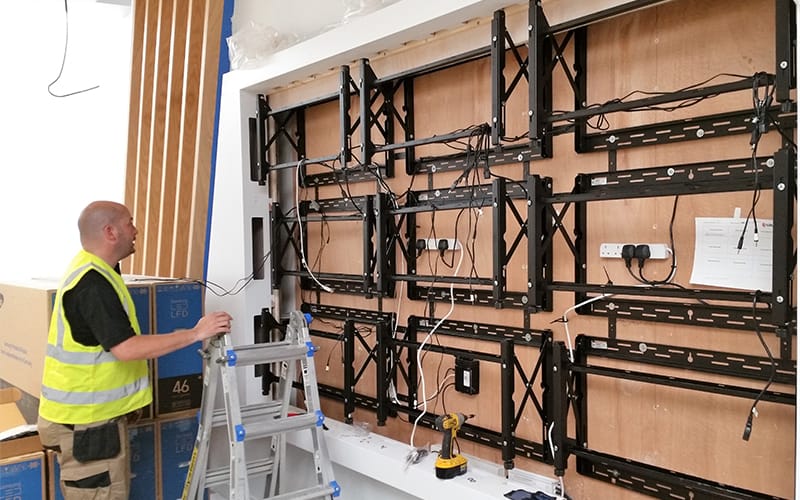Top 20 Most Common Digital Signage Mistakes
Digital signage offers an efficient and flexible way to communicate but it’s easy to make mistakes with it, and problems can be expensive to solve.
We’ll help you avoid the 20 most common mistakes people make with their digital signage content, systems, software and more.
Top 10 Common Mistakes in Using Digital Signage
- Using an inappropriate screen — It’s not a given that the screen you want to use will be compatible with your software or other hardware, so you need to check this before you buy it. Also, the screen has to be the appropriate size for the space it’s serving and whatever job it’s supposed to be doing. Too small and you won’t get enough impact. Too large and close up to the audience, and the message will be difficult to see.
- Buying cheap & nasty hardware – The saying ‘buy cheap and you buy twice’ is true when it comes to digital signage. If your displays are important, they’re worth investing in to get reliable hardware.
- Buying things in the wrong order – Not all brands/types of digital signage hardware and software do the same things, and many aren’t compatible with each other. Decide exactly what functionality you need, then ask a specialist to specify the hardware for you (and ask them to confirm that it’s all compatible – not all digital signage companies do these checks!), then purchase your hardware and software accordingly.
- Mounting the screen too high — Screens need to be easy to see, or people won’t give them more than a cursory glance. It might seem appealing to have the screen high up to avoid cluttering a space or to avoid making it a target for vandals, but too high and it will be awkward and uninviting to look at.
- Positioning the signage incorrectly — Besides issues of height, sightlines, accessibility etc., the ideal position for your signage will depend on whether your targets can see it properly. If you situate a screen somewhere the majority of your target audience is unlikely to look, you’ll be wasting your money . However, if it’s too close to where your audience is standing/sitting, it will look pixelated and won’t deliver the results you’re looking for either. Consider the nearest and furthest distance that someone can comfortably see your content from, then think about the percentage of people likely to be in that ideal position, and the percentage that won’t be. This should help you identify whether you screen is in the right place.
- Using cheap software — The most effective digital signage estates generally have a powerful content management system (CMS) at their heart. Too often, companies believe that digital signage doesn’t work for them because they’ve used a cheap CMS — or even worse, a flashdrive, which restricts what they can do on screen and reduces the quality of the messages they send out. Good, cloud-based digital signage management software will make scheduling and screen layouts simple. It will also tend to have built-in features that make it easy to identify and fix problems remotely (e.g. system restarts).
- Being single-minded — Unlike a printed sign, digital signage is very flexible and can achieve many different things simultaneously, just by using different content. A single screen can be used for sales promotions and internal training, wayfinding and assisting with store/venue closing. This can be done simply through careful scheduling of content on different screens and at different times. Consider all the potential uses digital signage could have when building a strategy/business case, so you get maximum value for money from your estate.
- Not having clear objectives — For digital signage to be effective, you need clear, well-planned objectives for what you want to achieve. Without this, all you’re doing is throwing out random messages and hoping for the best. Consider what all your long and short-term goals should be.
- Not having a way to measure results — As with any marketing or advertising, you need a way to track your ROI, otherwise you’ll have no way of knowing whether your strategies are successful. Consider all the possible measures you could use to track how successful you’re being. Tracking your results will also indicate if you need to change how you’re doing things to be more successful.
- Not making displays inclusive – It’s important not to exclude different types of customer/visitor so you must ensure everyone can use it, including disabled people. There are lots of mounts now available that allow interactive displays to be moved up and down for those in wheelchairs or with mobility issues. There are also audio systems that can be added to displays making it possible for people with visibility issues to hear an audio version of what’s showing on screen.
Top 10 Digital Signage Content Mistakes
- Too wordy/busy-looking — A cluttered screen can demand too much time and attention from busy passers-by. If your information is essential (e.g. travel times) your audience may engage with it for longer, but for non-essential signage (e.g. advertisements) it’s best to be clear and concise.
- Poor res images — It’s easy to design graphics on a laptop or computer screen, only to find they look blurry or pixellated at large scale. Choose high-resolution images and photography that will scale well, and try to use scalable vector graphics for logos and other line art, for digital signage content that looks great at any size.
- No clear objective/call to action — Digital signage content needs a purpose, and in many cases that takes the form of a call to action. Tell the viewer what you want them to do, whether that’s buy your product, visit your website, contact you directly to place an order, or any other course of action.
- Content on screen too long — Whether your content is a slideshow or fully animated, it needs to keep to a reasonable pace. A screen that stays static for too long will lose the attention of anyone watching. In the worst case, they may even assume it has frozen and stop looking at it completely.
- Content not on screen long enough — If too-slow updates are boring, too-fast updates are confusing and risk your audience missing important details. Especially if your call to action and/or contact details are at the end, make sure you give people long enough to read all of your content and take note of your details.
- Poor scheduling — The timeliness of your content matters, and it’s easy to find your screens are still promoting a sale or offer that has now expired. If you’re not confident with scheduling, work with a digital signage content expert who will be able to plan an itinerary for your digital content campaign.
- Trying to use files incompatible with software — Again, this can boil down to a lack of expertise, which is completely understandable. If you’re struggling to get to grips with the right software and file formats for your digital signage content, outsource the design process to a digital professional.
- Text too small for viewing distance — The size of your text can depend on how much you need to fit on your screen, but in many cases it’s better to establish your font size first to ensure it’s readable at the expected viewing distance. From there, you can work on writing just enough words to fill the screen and get your message across.
- Not adjusting timing for target audience — Remember your audience when scheduling your content. That could be as simple as running more family-oriented offers during school holidays, or as complex as targeting different demographics at different times of day or week – whatever keeps your messaging most relevant.
- Forgetting to size aspect ratio — Keep the aspect ratio of your screen in mind (the ratio of width to height). For widescreen displays this is usually around 16:9 but if your screen has different dimensions, a vertical format or an unusual shape, you’ll need to produce content that fits it correctly.
Digital signage can provide a massive boost to your business, but only if you avoid the pitfalls. Get in touch with us to find out how to use it effectively.
Ready to make an impact?
Get in touch now for competitive prices, good advice, & slick project delivery




